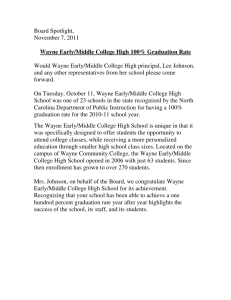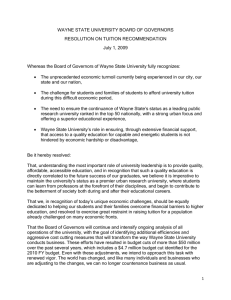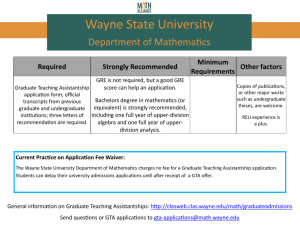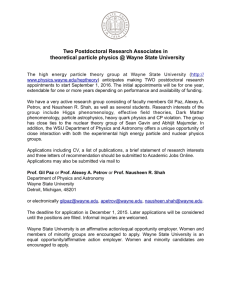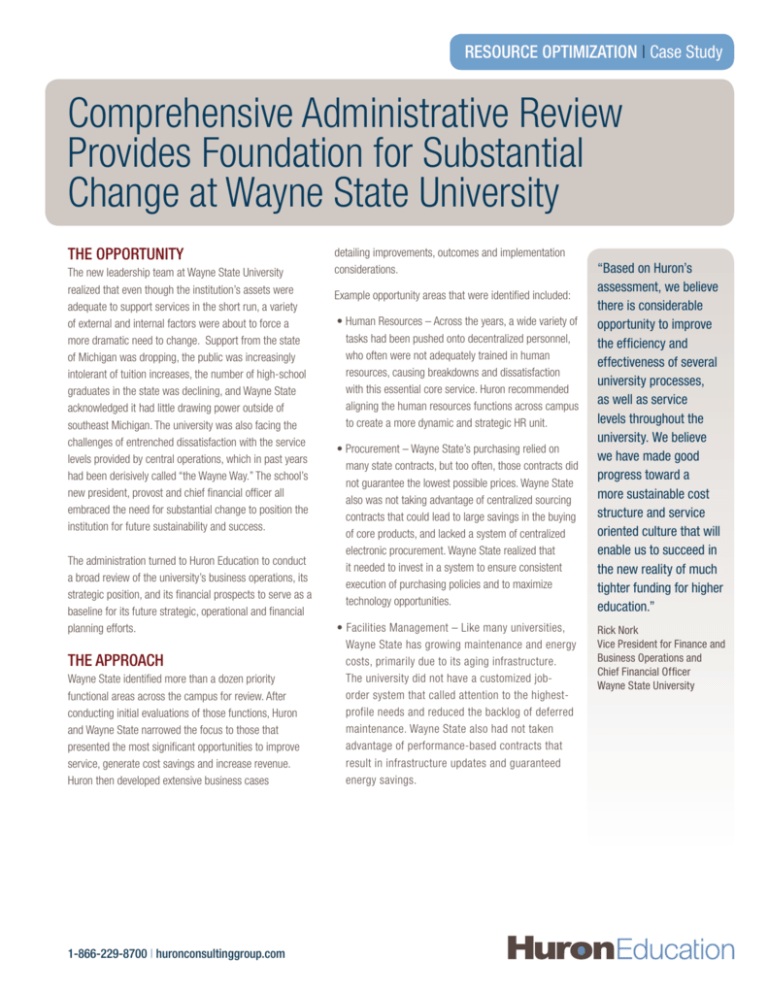
ResouRce optimization | Case Study
Comprehensive Administrative Review
Provides Foundation for Substantial
Change at Wayne State University
tHe oppoRtunitY
The new leadership team at Wayne State University
realized that even though the institution’s assets were
adequate to support services in the short run, a variety
of external and internal factors were about to force a
more dramatic need to change. Support from the state
of Michigan was dropping, the public was increasingly
intolerant of tuition increases, the number of high-school
graduates in the state was declining, and Wayne State
acknowledged it had little drawing power outside of
southeast Michigan. The university was also facing the
challenges of entrenched dissatisfaction with the service
levels provided by central operations, which in past years
had been derisively called “the Wayne Way.” The school’s
new president, provost and chief financial officer all
embraced the need for substantial change to position the
institution for future sustainability and success.
The administration turned to Huron Education to conduct
a broad review of the university’s business operations, its
strategic position, and its financial prospects to serve as a
baseline for its future strategic, operational and financial
planning efforts.
tHe appRoacH
Wayne State identified more than a dozen priority
functional areas across the campus for review. After
conducting initial evaluations of those functions, Huron
and Wayne State narrowed the focus to those that
presented the most significant opportunities to improve
service, generate cost savings and increase revenue.
Huron then developed extensive business cases
1-866-229-8700 | huronconsultinggroup.com
detailing improvements, outcomes and implementation
considerations.
Example opportunity areas that were identified included:
• Human Resources – Across the years, a wide variety of
tasks had been pushed onto decentralized personnel,
who often were not adequately trained in human
resources, causing breakdowns and dissatisfaction
with this essential core service. Huron recommended
aligning the human resources functions across campus
to create a more dynamic and strategic HR unit.
• Procurement – Wayne State’s purchasing relied on
many state contracts, but too often, those contracts did
not guarantee the lowest possible prices. Wayne State
also was not taking advantage of centralized sourcing
contracts that could lead to large savings in the buying
of core products, and lacked a system of centralized
electronic procurement. Wayne State realized that
it needed to invest in a system to ensure consistent
execution of purchasing policies and to maximize
technology opportunities.
• Facilities Management – Like many universities,
Wayne State has growing maintenance and energy
costs, primarily due to its aging infrastructure.
The university did not have a customized joborder system that called attention to the highestprofile needs and reduced the backlog of deferred
maintenance. Wayne State also had not taken
advantage of performance-based contracts that
result in infrastructure updates and guaranteed
energy savings.
“Based on Huron’s
assessment, we believe
there is considerable
opportunity to improve
the efficiency and
effectiveness of several
university processes,
as well as service
levels throughout the
university. We believe
we have made good
progress toward a
more sustainable cost
structure and service
oriented culture that will
enable us to succeed in
the new reality of much
tighter funding for higher
education.”
Rick Nork
Vice President for Finance and
Business Operations and
Chief Financial Officer
Wayne State University
Resource Optimization | Case Study
• Enrollment Services—Wayne State needed help
identifying students it could attract and retain. It wasn’t
using data to create a strategic plan for managing its
enrollment. Students who had enrolled expressed very
low satisfaction with the customer service at central
offices, often feeling that they were bounced between
the central offices for their needs. The central offices
also were slightly overstaffed and/or underutilized due
to the many inefficient processes in place.
• Information Technology – Wayne State had many
duplicative technology services that were provided
both centrally and de-centrally. Huron suggested that
the university could gain efficiency and productivity by
combining more of its IT support staff into a central unit.
• Budgeting – Wayne State’s budgeting methodology
provided few incentives for deans and vice presidents
of administrative units to reduce costs by rationalizing
consumption; furthermore, the University realized that
many of the cost reduction opportunities suggested by
Huron could only be realized with a more sophisticated
budget model that allocated specific line-item expense
categories—like office supplies—to individual
departments and other administrative units.
Huron’s recommendations for cost savings and operational
improvements, when implemented, will result in long-term
net annual recurring cost savings estimated at $9 million
to $13 million.
Wayne State has subsequently engaged the Huron
team to assist with the implementation of several of
the opportunities, as well as providing assistance with
1-866-229-8700 | huronconsultinggroup.com
© 2012 Huron Consulting Group Inc. All Rights Reserved.
v 15May11
program management and tracking of the benefits and
cost savings gained from these efforts.
THE RESULTS
The implementation work at Wayne State is continuing, but
has already shown some results.
• Wayne State has opened a one-stop office for all
students where they apply for admission, get financial-aid
assistance, register for classes, get transcripts, and other
similar services.
• Several pilot programs have been started which will
allow unit-level budgeting of facilities services through
the deployment of improved technology services.
• The strategic sourcing initiative has begun prioritizing
commodity areas and developing methods to get lower
prices within the identified areas through stronger
RFP processes and better contract negotiations. The
deployment of a selected eProcurement system will allow
for a streamlined procure-to-pay system.
• A Budgeting Summit was held with the various
administrative and academic leaders to begin
development of a new budgeting model.
• Consolidation of information technology services such as
file and print services are in progress.

